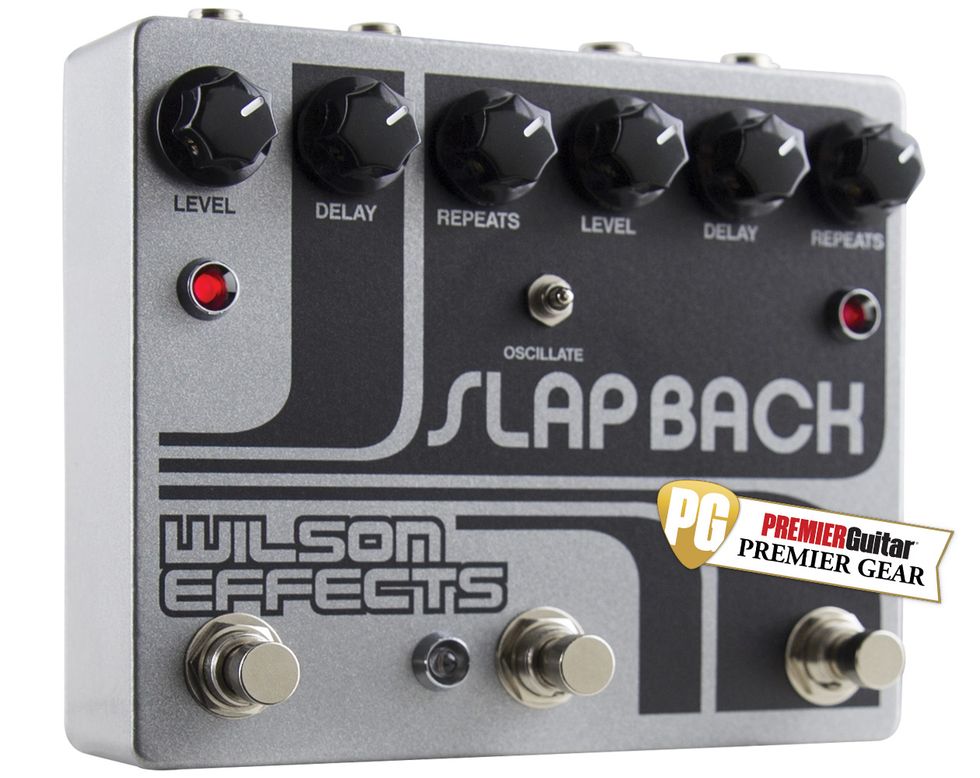0:00 – Effect off
0:07 – Medium-long delay on Ch2
0:23 – Slapback added in front (on Ch1)
0:39 – Oscillate switch engaged
0:54 – Slapback (short) delay on Ch1 only (Les Paul, both pickups on)
RatingsPros:Good-sounding delays with superbly flexible stereo and series-mono potential. Cons: Dialing in multi-delay settings that vary between songs can be tricky without presets. Street: $200 Wilson Effects Slapback Delay wilsoneffects.com | Tones: Ease of Use: Build/Design: Value: |
The Slapback digital delay from Indiana-based Wilson Effects delivers a lot of flexibility in a relatively easy-to-use pedal. But its introduction requires an addendum right up front: This pedal generates much more than slapback echoes. The two fully independent channels of delay deliver up to 700 ms each via many useful and clever routing options. Hold tight and we’ll run down the knobs and functions.
Echolocation
It’s simplest to view the Slapback as two fully independent delays in one box. Each has its own knobs for repeats, delay (time), and level, as well as independent ins and outs and individual on/off switches. As such, you can run input from a stereo effect and route the signal independently through the Slapback to individual amps, go mono-in and run them to two amps at the varied settings of your choosing, or run one delay into the front end of an amp and another to an amplifier effects loop.
Cascading the two delays in series simply requires routing your guitar signal into the right channel input, using the left channel output exclusively, and turning both delays on. The latching center footswitch, meanwhile, allows you to trigger one side or the other into repeating oscillation, which you can assign using the oscillate toggle switch.
The circuit inside the 5.7" x 4.7" die-cast-aluminum box uses digital PT2399 chips to generate the echoes. Given the space constraints, there’s no room for a battery, so its external 9V DC only, which is supplied by a standard 2.1 mm center-negative power supply (not included).
Slap and Tickle
I tested the Slapback using a tweed Deluxe-style amp and Carr Mercury V combos—both side by side and individually—and played a PRS CE22 and a Fender Telecaster. In all setups, the Slapback provided a wealth of echo-tastic delights. And even after deep, diligent exploration I constantly uncovered fun new applications.
The Slapback’s core echo tones are both appealingly crisp and rich. And when used in mono as a simple dual-option delay, the Slapback still provides a ton of versatility. The most obvious application is dialing in a slapback on the first circuit and setting a longer echo on the second to use separately. Run both together and you get rockabilly bounce with haunting atmospheric delay on its tail. The cascading mono mode also sounded great with two similar, but not identical, delay times—producing an ethereal cut-time spin that most standard echoes can’t achieve. And it’s all easily sent spiraling into mayhem by stomping the oscillation button. Background noise is compounded a little when using the two circuits in series, but not enough to be noticeable once you start playing.
Used in stereo (or perhaps “dual-mono” is more accurate) with two amps, the Slapback is capable of spreading a wide, wet soundscape within a room. Part of the fun is how you can fine-tune your left-and-right delay times and depths easily on the fly, rather than being at the mercy of a stereo preset. The flipside of that advantage, of course, is that you’ve got two sets of knobs to twiddle to achieve different stereo setups from song to song. But many players will consider that a small price to pay for this kind of hands-on versatility.
The Verdict
The Slapback offers an enormous range of delay-crafting possibilities from a well-made unit that is really quite affordable when compared to many deluxe, multi-function boutique delay pedals. It’s designed to suit many different types of rigs, from simple to stereo, but is intuitive and simple to use. And even if you don’t foresee needing all of its potential functions right away, it’s overflowing with possibilities.









![Rig Rundown: Russian Circles’ Mike Sullivan [2025]](https://www.premierguitar.com/media-library/youtube.jpg?id=62303631&width=1245&height=700&quality=70&coordinates=0%2C0%2C0%2C0)

















